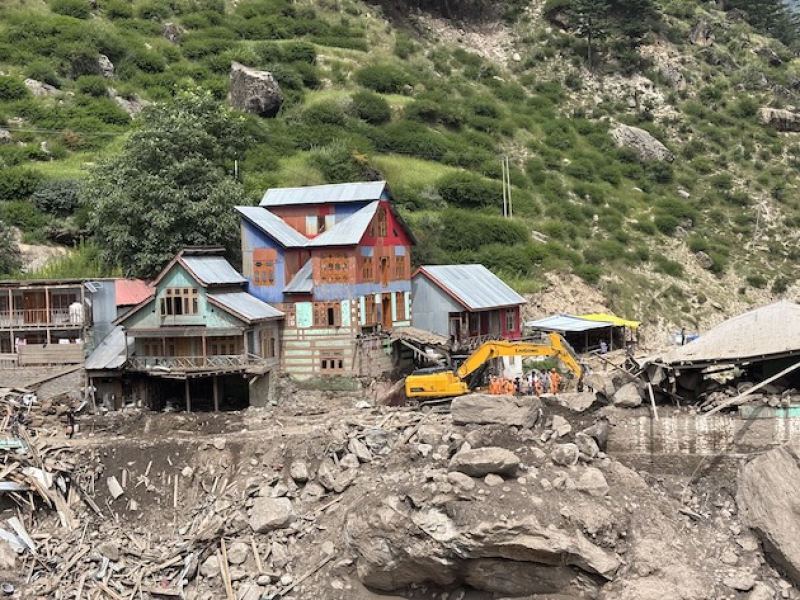- Tarique Rahman returns home amid rapturous reception |
- Home After 17 Years: Tarique Returns to Gulshan Residence |
- Tarique Calls for United Effort to Build a Safe Bangladesh |
- Tarique leaves for 300 feet area from airport |
- BNP top leaders welcome Tarique Rahman on homecoming |
Kashmir’s August Deluge: Lives, Livelihoods Shattered

The Kishtwar cloudburst on August 26 buried Chesoti village beneath a torrent of mud and boulders, killing at least 65 people, with several still missing.
The relentless rain that battered the mountains and valleys of Jammu and Kashmir this August shattered lives and records.
In just 31 days, more than 100 people were killed, scores of families displaced, and entire communities devastated—not only by the sheer force of nature but also by the uncertainty and chaos that followed.
August 2025 will be remembered for the scale and frequency of its natural disasters. According to the India Meteorological Department (IMD), Jammu and Kashmir experienced its sixth wettest August in 125 years, with 319.3 mm of rainfall—73 percent above average.
“We recorded over 30 extreme weather events this month, including flash floods, cloudbursts, landslides, gusty winds, and thunderstorms. At least 14 of these resulted in fatalities,” confirmed Dr. Mukhtar Ahmad, Director of the Meteorological Department.
Among the most devastating incidents was the Kishtwar cloudburst on 26 August, which buried Chesoti village beneath mud and boulders, killing at least 65 people, with several still missing. Days later, a landslide along the Vaishno Devi route in Jammu claimed 35 more lives, many of them Hindu pilgrims.
Inside a makeshift shelter near Chesoti, 45-year-old Ghulam Nabi recounted the horror of that night.
“We heard a roar like a thousand waterfalls. There wasn’t even time to scream. The earth shook, and then everything was dark and wet.”
He lost his wife and two children—their bodies recovered days later by rescue teams.
“I never thought the mountain would come for us. We always feared the river, but it was the hillside that swallowed my family,” Nabi said.
In Reasi, 13-year-old Manisha Devi clutched a photograph of her elder brother, who had travelled to the Vaishno Devi shrine to work as a porter.
“He sent me money so I could buy books. Now he is gone, and so is our house,” she said.
Experts say the frequency and intensity of such disasters cannot be dismissed as coincidence.
“There is clear evidence that climate change is making rainfall events more erratic and intense, especially in mountainous regions,” explained Faizan Arif Keng, an independent weather forecaster. “Doda received 290 percent more rainfall than normal. Udhampur, Ramban, and Samba also had more than double their usual rainfall.”
Kargil recorded a 1,530 percent surplus, while Leh saw nearly 900 percent above average rainfall—figures described as “unprecedented” by Keng.
For many, the storms also brought economic ruin. The closure of the Srinagar–Jammu National Highway left thousands of trucks carrying apples, pears, and plums stranded for days. The result: rotting fruit and collapsing prices.
At Sopore Fruit Market, Asia’s second-largest fruit trading hub, the atmosphere was grim.
“We are staring at losses of around Rs 200 crore (about USD 22 million). If trucks cannot reach markets on time, growers lose everything,” said Fayaz Ahmed Malik, president of the market.
Grower Abdul Rashid, standing beside his damaged apple boxes, voiced his frustration: “I spent all year in the orchard. Now the apples are ruined. Buyers pay half the rate, sometimes less. How do I feed my family or repay debts?”
With the crisis deepening, India’s Ministry of Home Affairs announced the formation of Inter-Ministerial Central Teams (IMCTs) to assess the damage across northern states hit by extreme weather. Officials promised faster fund releases, but in several districts, search and rescue operations are still underway.
So far, Rs 2,090 million (about USD 11.9 million) has been released to Jammu and Kashmir under the State Disaster Response Fund, with more sanctioned under the National Disaster Relief Fund.
Still, experts warn that relief alone is not enough. “We need investment in community-level disaster preparedness, early warning systems, and stricter construction rules in vulnerable zones. The people are resilient, but they need support to adapt,” said Mudasir Ahmad Mir, a researcher at the University of Kashmir.
In Chesoti, Ghulam Nabi’s voice carries a plea: “We are simple people. We don’t ask for much. But we want to live without fear every time it rains. Can someone tell us when the next storm will come?”
Community solidarity has been a source of hope. Volunteers from neighbouring villages, religious organisations, and NGOs have distributed food, clothes, and medicines.
“It’s the people who save each other when the government is stretched thin,” said Manzoor Ahmad, a teacher from Ramban who is helping coordinate aid.
But the scars remain deep. For children like Manisha, every thunderstorm brings back memories of loss. For farmers like Abdul Rashid, financial collapse overshadows the joy of harvest.
“August will end,” said Malik at Sopore market, “but its wounds will take much longer to heal. We need help, yes—but also empathy from those in power.”

